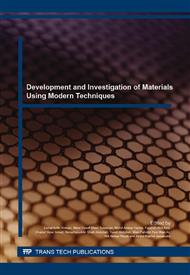p.170
p.175
p.180
p.185
p.191
p.197
p.202
p.207
p.213
Modification of Rubber Particles and Ceramic Fillers on PMMA Denture Base Materials
Abstract:
The purpose of this study is to investigate the effect of nitrile butadiene rubber (NBR) particles and ceramic fillers on the density of PMMA denture base materials. The denture base was prepared based on the mixture of PMMA powder and MMA liquid. The density of the denture base has been modified by adding three different ratios of nitrile rubber (5, 7.5 and 10 wt %), three types of ceramic fillers (Al2O3, YSZ and SiO2, respectively) fixed at 5 wt %, 0.5% of benzoyl peroxide (PBO) and ethylene glycol dimethacryate (10 wt% EGDMA). The powder/liquid (P/L) was mixed by 2.5:1 g ratio. At 10 wt% of NBR the denture base density has reduced to 50%. Furthermore, the addition of ceramic fillers together with NBR particles has also reduced the denture base density. The density data was statistically analysed by on-way (ANOVA) and the values were significantly effect when addition of rubber particles in PMMA denture base composite (p < 0.05).Therefore, the density issue can be easily adjusted in retention and stability of denture base in the patient mouth.
Info:
Periodical:
Pages:
191-196
Citation:
Online since:
January 2016
Authors:
Price:
Сopyright:
© 2016 Trans Tech Publications Ltd. All Rights Reserved
Share:
Citation:


